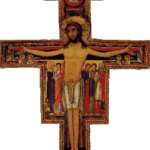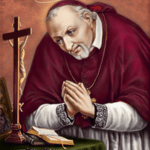The Good Friday Way of the Cross.
There are various devotional stations of the Cross, but two have had the most popularity for years.
One is that from St. Francis of Assisi and the other from St. Alphonsus Ligouri.
What’s the difference? Not that much really, It’s 14 Stations and a journey along the way of Jesus going from Pilate’s temple to the tomb of His burial.
Yet there are some notable things ‘different’ of these ones from a Franciscan founder saint and a Redemptorist founder saint.
I would like to first point out that both St. Francis of Assisi and St. Alphonsus Liguori had very deep devotions to the Sacred Passion of Christ and this spilled out into their intimate spirituality of Jesus Crucified.
St. Francis of Assisi was traditionally only a deacon and the first official stigmatized saint. Great was his devotion to the Passion of Christ. One day he heard the Lord telling him to “Rebuild My Church. One day when Francis went out to meditate in the fields he was passing by the church of San Damiano which was threatened to collapse because of extreme age. Inspired by the Spirit, he went inside to pray. Kneeling before an image of the Crucified, he was filled with great fervor and consolation as he prayed. While his tear-filled eyes were gazing at the Lord’s cross, he heard with his bodily ears a voice coming from the cross, telling him three times, ‘Francis, go repair my house, as you see, it is falling into ruin’” (Life of St. Francis, St. Bonaventure).
 Today, the Franciscans use a San Damiano Cross. It is recognizable in many Franciscan houses of worship and places. Francis would be pleased that much attention be given to Christ on The Cross.
Today, the Franciscans use a San Damiano Cross. It is recognizable in many Franciscan houses of worship and places. Francis would be pleased that much attention be given to Christ on The Cross.
St. Alphonsus Liguori equally had a tremendous devotion to the Christ Crucified and was the founder of the Congregation of the Most Holy Redeemer also known as the Redemptorists. You can recall the phrase from their version: “We adore You, O Christ, and we praise You, because by Your Holy Cross You have redeemed the world. “
Your Holy Cross You have redeemed the world. “
The two forms of the Way of the Cross are encouraged by Holy Mother Church. The Franciscan form is not only older, it is considered the traditional Way of the Cross. In fact up until Vatican II, the erection of the Fourteen (14) Stations of the Cross was reserved to be erected by Franciscan Friars only: Their Way of the Cross flows out from a Franciscan spirituality. It also notes how Francis saw the Lord Crucified and receive a stigmata.
The Way of the Cross according to St. Alphonsus follows a Redemptorist spirituality which has more of a liturgical flavor, which can be see as it has the Stabat Mater impregnated in this devotion. It [puts St. Mary squarely in the Passion of her Son, she is faithful to Jesus to the end. The Stabat Mater is from a 13th-century Christian hymn to Mary, which portrays her suffering as Jesus Christ’s mother during his crucifixion. “Stabat Mater dolorosa” means “the sorrowful mother was standing (there at Calvary)” The Patroness of the Redemptorists is the Blessed Virgin Mary under the title “Immaculate Conception,” of which St. Alphonsus was the strong propagator even before Marian Dogma was officially promulgated.
In areas with a Franciscan Influence will probably use the Franciscan form of the Way of the Cross; while parishes that have a great Marian devotion may tend to say the Stations of the Cross of St. Alphonsus Liguori. In any case, both forms are to be encouraged.
This Year of the Eucharist I composed a Way of the Cross at Adoration time. We used it all Friday nights of Lent, at 6:30 p.m. as we began our usual Adoration time/ Holy Hour. A few years ago I composed a Laudato Si Stations collection, based on the ecological emphasis of Pope Francis.
The Stations of the Cross or the Way of the Cross, is also known as the Way of Sorrows or the Via Crucis or Via Dolorosa. It refers to a series of images depicting Jesus on the day of His crucifixion. and accompanying prayers. The stations grew out of imitations of the one done for a long time in Jerusalem in its streets, on a traditional processional route symbolizing the path Jesus walked to Mt. Calvary. The objective of the stations is to help the Christian faithful to make a special prayer with Christ’ final passion.


What an interesting perspective on the stations of the cross! Thank you, Father.